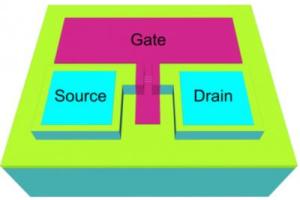May 16 2014
A new approach to integrated circuits, combining atoms of semiconductor materials into nanowires and structures on top of silicon surfaces, shows promise for a new generation of fast, robust electronic and photonic devices.
Engineers at the University of California, Davis, have recently demonstrated three-dimensional nanowire transistors using this approach that open exciting opportunities for integrating other semiconductors, such as gallium nitride, on silicon substrates.
 UC Davis engineers are growing wires and bridges of other semiconductors on silicon to create a new generation of devices. This schematic shows how nanowires can be incorporated into a device. (Credit: Saif Islam, UC Davis)
UC Davis engineers are growing wires and bridges of other semiconductors on silicon to create a new generation of devices. This schematic shows how nanowires can be incorporated into a device. (Credit: Saif Islam, UC Davis)
"Silicon can't do everything," said Saif Islam, professor of electrical and computer engineering at UC Davis. Circuits built on conventionally etched silicon have reached their lower size limit, which restricts operation speed and integration density. Additionally, conventional silicon circuits cannot function at temperatures above 250 degrees Celsius (about 480 degrees Fahrenheit), or handle high power or voltages, or optical applications.
The new technology could be used, for example, to build sensors that can operate under high temperatures, for example inside aircraft engines.
"In the foreseeable future, society will be dependent on a variety of sensors and control systems that operate in extreme environments, such as motor vehicles, boats, airplanes, terrestrial oil and ore extraction, rockets, spacecraft, and bodily implants," Islam said.
Devices that include both silicon and nonsilicon materials offer higher speeds and more robust performance. Conventional microcircuits are formed from etched layers of silicon and insulators, but it's difficult to grow nonsilicon materials as layers over silicon because of incompatibilities in crystal structure (or "lattice mismatch") and differences in thermal properties.
Instead, Islam's laboratory at UC Davis has created silicon wafers with "nanopillars" of materials such as gallium arsenide, gallium nitride or indium phosphide on them, and grown tiny nanowire "bridges" between nanopillars.
"We can't grow films of these other materials on silicon, but we can grow them as nanowires," Islam said.
The researchers have been able to make these nanowires operate as transistors, and combine them into more complex circuits as well as devices that are responsive to light. They have developed techniques to control the number of nanowires, their physical characteristics and consistency.
Islam said the suspended structures have other advantages: They are easier to cool and handle thermal expansion better than planar structures — a relevant issue when mismatched materials are combined in a transistor.
The technology also leverages the well-established technology for manufacturing silicon integrated circuits, instead of having to create an entirely new route for manufacturing and distribution, Islam said.
The work is described in a series of recent papers in the journals Advanced Materials, Applied Physics Letters and IEEE Transactions on Nanotechnology with co-authors Jin Yong Oh at UC Davis; Jong-Tae Park, University of Incheon, South Korea; Hyun-June Jang and Won-Ju Cho, Kwangwoon University, South Korea. Funding was provided by the U.S. National Science Foundation and the government of South Korea.